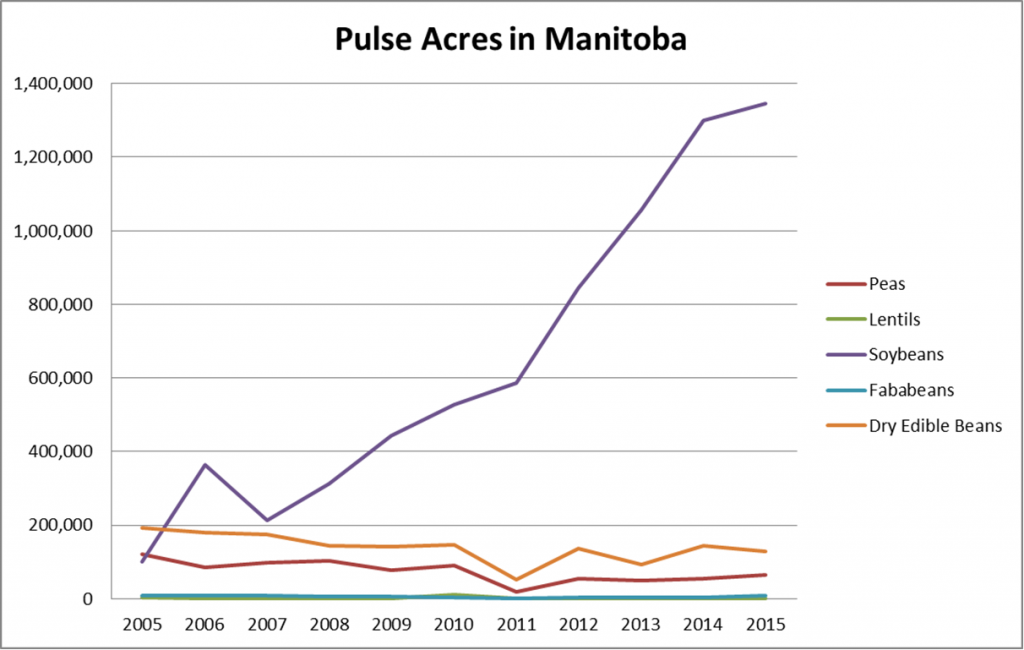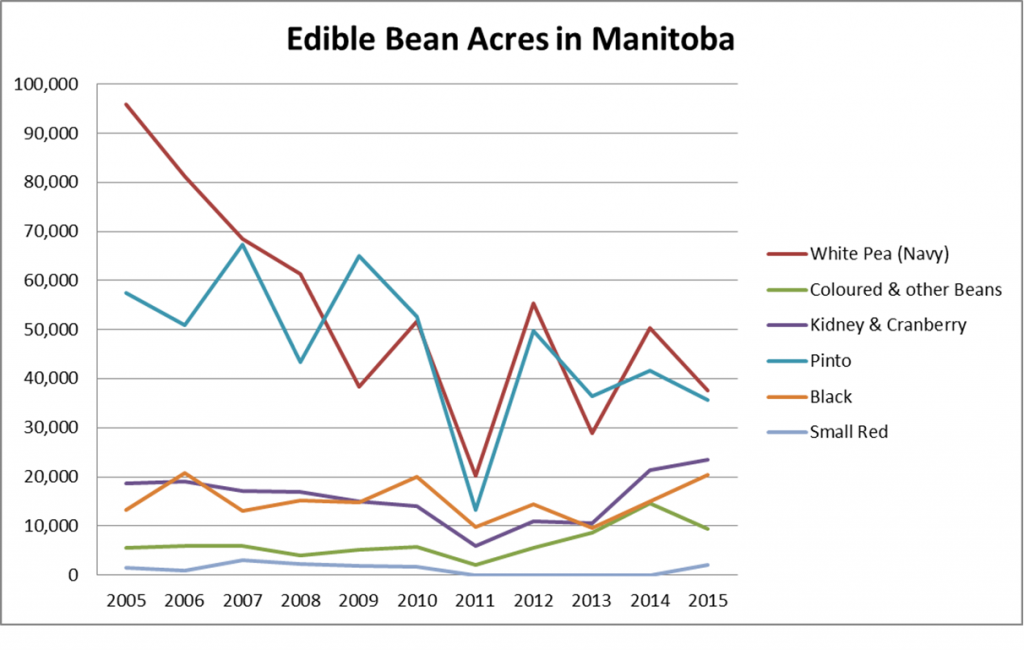Pulse and soybean farmers are an important part of Manitoba’s agricultural economy. Presently there are over 3,800 pulse and soybean farmers in Manitoba. Canada is the world’s largest exporter and one of the world’s largest producers of pulses and Manitoba pulse crops play a huge part in that role. Manitoba is one of the largest producer of dry beans in Canada. Most Canadian soybeans are destined for the United States, most edible beans are exported to Angola, United States, United Kingdom and Mexico, and most peas are sent to China, Brazil, India and Venezuela.
Pulse and soybean crops can be planted under conventional, minimum till or zero till production systems with a wide range of seeding equipment including double disc press drills, hoe drills, discers, row-crop planters, air drills and air seeders.
Lentils, peas, and chickpeas are cool season crops that can be seeded early. All are tolerant of light frosts (-4 to -6°C). Best yields and quality usually result from early seeding as soon as the top inch (2.5 cm) of the soil reaches 5°C, provided the soil is not excessively wet.
Dry beans are a warm season crop that have no frost tolerance. Best yields of dry bean usually arise from seeding later than other pulse crops, when frost risk is low and the soil temperature at seeding depth has reached a minimum of 12°C.
Soybeans are a long-season crop and require a warm growing season to reach maturity. To obtain best yields and high quality, seeding should take place in early spring, before June. Soybeans can tolerate excess sol moisture better than most other crops.
Lentils, peas and chickpeas prefer dry soil and weather conditions, and are generally planted in brown soil zones, where water can drain quickly. Dry beans and soybeans grow best in black soil zones, although dry beans will do better on land that drains quickly, as their moisture tolerance is not as high as soybeans. Pulse crops are harvested low to the ground so land without stones is strongly preferred, though rolling can alleviate problems with stones.
In Manitoba, peas and lentils are grown in the western part of the province. Dry bean acres are focused around south central Manitoba, namely Portage la Prairie, Carman, Morden, Winkler and Altona. Manitoba soybeans were first cropped in the Red River Valley, but production has expanded to areas north and east of Winnipeg, west to Brandon and north to Dauphin.

| Peas | Lentils | Soybeans | Fababean | Dry Edible Beans | |
|---|---|---|---|---|---|
| 2005 | 120,570 | 2,228 | 100,457 | 9,705 | 192,319 |
| 2006 | 85,070 | 270 | 363,788 | 8,533 | 178,475 |
| 2007 | 97,076 | 172 | 213,157 | 7,905 | 175,104 |
| 2008 | 102,175 | 385 | 312,518 | 6,048 | 143,164 |
| 2009 | 76,642 | 2,027 | 441,938 | 5,414 | 140,232 |
| 2010 | 89,587 | 10,063 | 528,127 | 4,577 | 145,825 |
| 2011 | 18,996 | 892 | 587,382 | 1,986 | 51,182 |
| 2012 | 53,283 | 877 | 844,600 | 3,463 | 135,800 |
| 2013 | 49,046 | 533 | 1,056,652 | 2,377 | 93,988 |
| 2014 | 55,650 | 0 | 1,298,688 | 3,468 | 142,811 |
| 2015 | 63,969 | 1,707 | 1,346,349 | 9,040 | 128,497 |

| White Pea (Navy) | Coloured & Other Beans | Kidney & Cranberry | Pinto | Black | Small Red | |
|---|---|---|---|---|---|---|
| 2005 | 95,919 | 5,577 | 18,625 | 57,435 | 13,292 | 1,471 |
| 2006 | 81,132 | 5,846 | 18,998 | 50,849 | 20,720 | 930 |
| 2007 | 68,522 | 5,894 | 17,141 | 67,384 | 13,108 | 3,055 |
| 2008 | 61,384 | 4,043 | 17,009 | 43,320 | 15,245 | 2,163 |
| 2009 | 38,378 | 5,212 | 14,985 | 14,985 | 64,877 | 1,809 |
| 2010 | 51,659 | 5,650 | 14,088 | 52,724 | 20,049 | 1,655 |
| 2011 | 20,131 | 1,997 | 5,908 | 13,342 | 9,804 | 0 |
| 2012 | 55,274 | 5,440 | 10,842 | 49,746 | 14,498 | 0 |
| 2013 | 28,913 | 8,568 | 10,568 | 36,404 | 9,535 | 0 |
| 2014 | 50,273 | 14,545 | 21,452 | 41,620 | 14,921 | 0 |
| 2015 | 37,602 | 9,434 | 23,452 | 35,572 | 20,302 | 2,135 |
